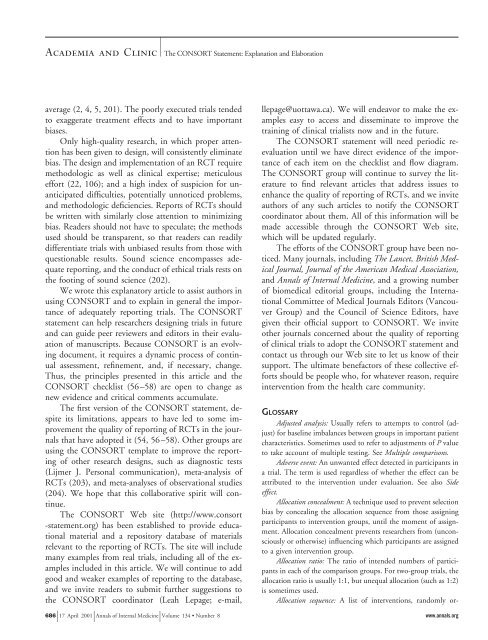The Revised CONSORT Statement for Reporting Randomized Trials
The Revised CONSORT Statement for Reporting Randomized Trials
The Revised CONSORT Statement for Reporting Randomized Trials
Create successful ePaper yourself
Turn your PDF publications into a flip-book with our unique Google optimized e-Paper software.
Academia and Clinic <strong>The</strong> <strong>CONSORT</strong> <strong>Statement</strong>: Explanation and Elaboration<br />
average (2, 4, 5, 201). <strong>The</strong> poorly executed trials tended<br />
to exaggerate treatment effects and to have important<br />
biases.<br />
Only high-quality research, in which proper attention<br />
has been given to design, will consistently eliminate<br />
bias. <strong>The</strong> design and implementation of an RCT require<br />
methodologic as well as clinical expertise; meticulous<br />
ef<strong>for</strong>t (22, 106); and a high index of suspicion <strong>for</strong> unanticipated<br />
difficulties, potentially unnoticed problems,<br />
and methodologic deficiencies. Reports of RCTs should<br />
be written with similarly close attention to minimizing<br />
bias. Readers should not have to speculate; the methods<br />
used should be transparent, so that readers can readily<br />
differentiate trials with unbiased results from those with<br />
questionable results. Sound science encompasses adequate<br />
reporting, and the conduct of ethical trials rests on<br />
the footing of sound science (202).<br />
We wrote this explanatory article to assist authors in<br />
using <strong>CONSORT</strong> and to explain in general the importance<br />
of adequately reporting trials. <strong>The</strong> <strong>CONSORT</strong><br />
statement can help researchers designing trials in future<br />
and can guide peer reviewers and editors in their evaluation<br />
of manuscripts. Because <strong>CONSORT</strong> is an evolving<br />
document, it requires a dynamic process of continual<br />
assessment, refinement, and, if necessary, change.<br />
Thus, the principles presented in this article and the<br />
<strong>CONSORT</strong> checklist (56–58) are open to change as<br />
new evidence and critical comments accumulate.<br />
<strong>The</strong> first version of the <strong>CONSORT</strong> statement, despite<br />
its limitations, appears to have led to some improvement<br />
the quality of reporting of RCTs in the journals<br />
that have adopted it (54, 56–58). Other groups are<br />
using the <strong>CONSORT</strong> template to improve the reporting<br />
of other research designs, such as diagnostic tests<br />
(Lijmer J. Personal communication), meta-analysis of<br />
RCTs (203), and meta-analyses of observational studies<br />
(204). We hope that this collaborative spirit will continue.<br />
<strong>The</strong> <strong>CONSORT</strong> Web site (http://www.consort<br />
-statement.org) has been established to provide educational<br />
material and a repository database of materials<br />
relevant to the reporting of RCTs. <strong>The</strong> site will include<br />
many examples from real trials, including all of the examples<br />
included in this article. We will continue to add<br />
good and weaker examples of reporting to the database,<br />
and we invite readers to submit further suggestions to<br />
the <strong>CONSORT</strong> coordinator (Leah Lepage; e-mail,<br />
llepage@uottawa.ca). We will endeavor to make the examples<br />
easy to access and disseminate to improve the<br />
training of clinical trialists now and in the future.<br />
<strong>The</strong> <strong>CONSORT</strong> statement will need periodic reevaluation<br />
until we have direct evidence of the importance<br />
of each item on the checklist and flow diagram.<br />
<strong>The</strong> <strong>CONSORT</strong> group will continue to survey the literature<br />
to find relevant articles that address issues to<br />
enhance the quality of reporting of RCTs, and we invite<br />
authors of any such articles to notify the <strong>CONSORT</strong><br />
coordinator about them. All of this in<strong>for</strong>mation will be<br />
made accessible through the <strong>CONSORT</strong> Web site,<br />
which will be updated regularly.<br />
<strong>The</strong> ef<strong>for</strong>ts of the <strong>CONSORT</strong> group have been noticed.<br />
Many journals, including <strong>The</strong> Lancet, British Medical<br />
Journal, Journal of the American Medical Association,<br />
and Annals of Internal Medicine, and a growing number<br />
of biomedical editorial groups, including the International<br />
Committee of Medical Journals Editors (Vancouver<br />
Group) and the Council of Science Editors, have<br />
given their official support to <strong>CONSORT</strong>. We invite<br />
other journals concerned about the quality of reporting<br />
of clinical trials to adopt the <strong>CONSORT</strong> statement and<br />
contact us through our Web site to let us know of their<br />
support. <strong>The</strong> ultimate benefactors of these collective ef<strong>for</strong>ts<br />
should be people who, <strong>for</strong> whatever reason, require<br />
intervention from the health care community.<br />
GLOSSARY<br />
Adjusted analysis: Usually refers to attempts to control (adjust)<br />
<strong>for</strong> baseline imbalances between groups in important patient<br />
characteristics. Sometimes used to refer to adjustments of P value<br />
to take account of multiple testing. See Multiple comparisons.<br />
Adverse event: An unwanted effect detected in participants in<br />
a trial. <strong>The</strong> term is used regardless of whether the effect can be<br />
attributed to the intervention under evaluation. See also Side<br />
effect.<br />
Allocation concealment: A technique used to prevent selection<br />
bias by concealing the allocation sequence from those assigning<br />
participants to intervention groups, until the moment of assignment.<br />
Allocation concealment prevents researchers from (unconsciously<br />
or otherwise) influencing which participants are assigned<br />
to a given intervention group.<br />
Allocation ratio: <strong>The</strong> ratio of intended numbers of participants<br />
in each of the comparison groups. For two-group trials, the<br />
allocation ratio is usually 1:1, but unequal allocation (such as 1:2)<br />
is sometimes used.<br />
Allocation sequence: A list of interventions, randomly or-<br />
686 17 April 2001 Annals of Internal Medicine Volume 134 • Number 8 www.annals.org
















